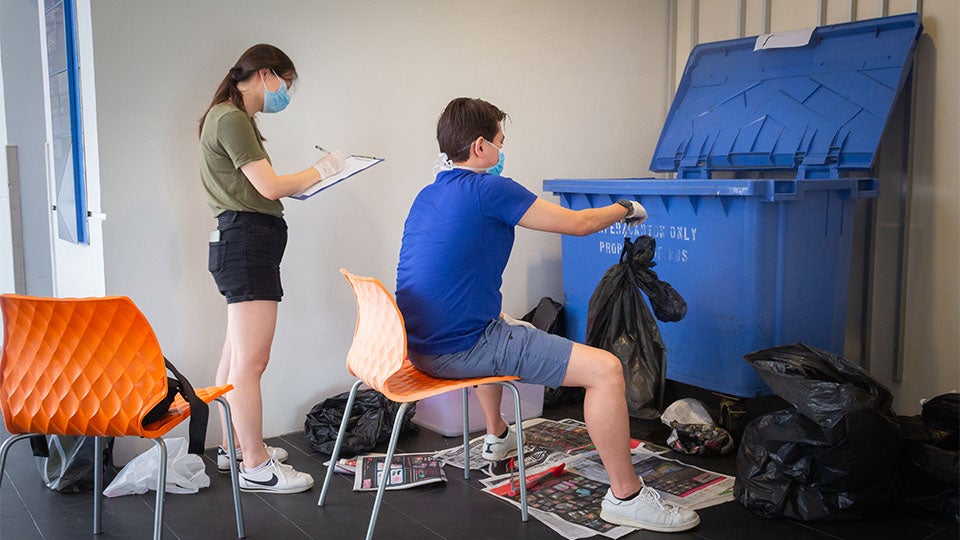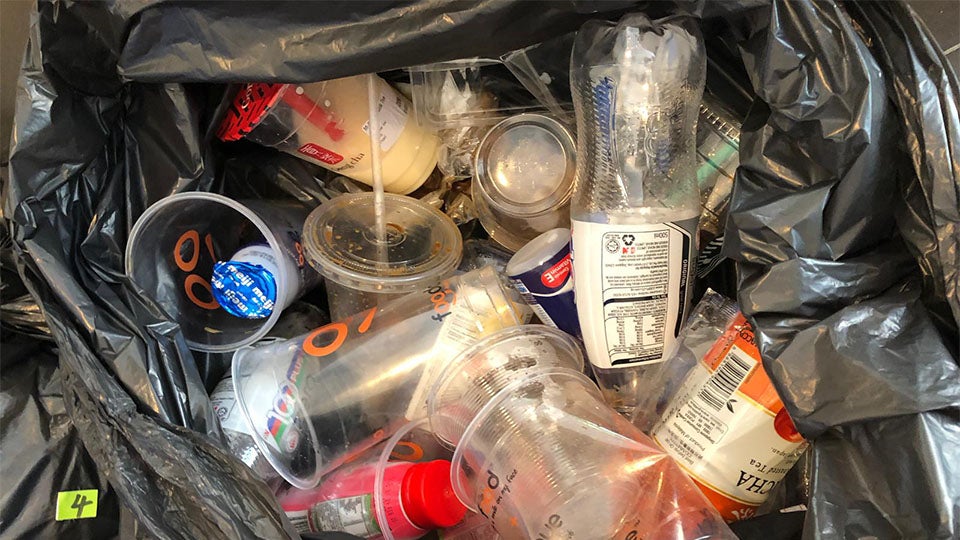The NUS Zero Waste Taskforce partnered with a multi-disciplinary group of NUS students between January and March 2020, to conduct a study to uncover insights on the recycling behaviour of the NUS community, and examine the effectiveness of recycling bin “triggers” in reducing the amount of non-recyclables in recycling bins.
While the recycling rate in NUS has risen from 17 to 24 per cent between 2016 and 2019, the recycling for plastic, the recycling for metal and paper waste streams have declined by 60 per cent in the same period due to the contamination in recycling bins caused by food and liquid waste, making them unsuitable for recycling. This same problem persists across Singapore[1].
A detailed waste contamination analysis was carried
out as part of the study. The research team, comprising students majoring in
industrial design, statistics and engineering, spent about 120 hours over 42
days “dumpster diving” to sort the contents of more than 2,150 recycling bags
in UTown and NUS Engineering to determine the proportions of non-recyclables
and recyclables in recycling bins. This was the first time such a detailed
waste contamination analysis was carried out for public recycling bins in NUS.
[1] https://www.nea.gov.sg/media/news/news/index/60-per-cent-of-singaporean-households-recycle-regularly

The team’s analysis revealed that the contamination rate (proportion of non-recyclables vs recyclables) for plastic recycling bins before any recycling intervention was introduced, was high at an average of 57 per cent and 46 per cent for UTown and NUS Engineering respectively. The metal recycling bins, on the other hand, had a lower contamination rate of 37 per cent and 15 percent at UTown and NUS Engineering respectively. Contamination was also found to be higher in recycling bins placed near food establishments, and lower when the recycling bins were paired with rubbish bins without lids.

Leveraging the data and insights gathered from the contamination analysis, the industrial designers from the research team then test-bedded new recycling bin features aimed at reducing the amount of non-recyclables thrown into recycling bins.
These included a recycling ‘speedbump’ to slow down the act of disposal to encourage proper recycling, and an educational ‘Recycle Right’ banner highlighting the common wrong items thrown into recycling bins based on the contamination analysis conducted.

It was observed that the recycling ‘speedbumps’ reduced the contamination rate in the metal recycling bins by about 14 percent, but both the ‘speedbumps’ and ‘Recycle Right’ banner interventions had no impact on reducing contamination in the plastic recycling bins.
In addition, the students carried out a face-to-face survey with over 350 staff and students who used recycling bins in UTown. Their survey revealed that while the respondents had good knowledge on what could be recycled, about 25 per cent were not aware that used food packaging with some oil stains or bubble tea cups with a few drops of liquid cannot be recycled. These findings explained why the contamination persisted despite the new interventions.

Year 2 statistics student Hemashree A from NUS Statistics and Applied Probability, who conducted the analysis for the project, reflected, “This project has taught me how to apply the quantitative methods I have learnt in my statistics class to a real-world practical setting to produce evidence-based recommendations to decision makers.”
The overall findings from the in-depth behaviourial study have facilitated the research team in proposing recommendations to help improve NUS’ campus recycling programme. The recommendations included a new intuitive recycling bin design, stepping up “Recycle Right” education efforts, and the gradual phasing out of single-use plastics on campus.
Senior Director (Operations and Maintenance) Mr Chew Chin Huat from NUS University Campus Infrastructure said, “The study conducted by our students provided robust, valuable insights and recommendations to improve our campus recycling programme. We look forward to implementing these recommendations in the new semester to continue encouraging the NUS community to recycle right and reduce waste.”
Read more from NUS news on Nudging proper recycling: An in-depth waste analysis



